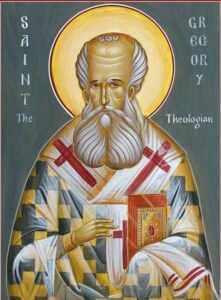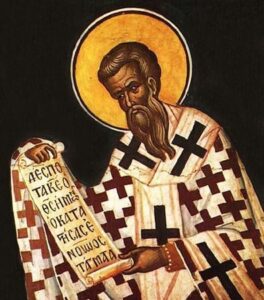St. Gregory of Nazianzus, the Theologian – Jan 1 I Cappadocian Father

Gregory of Nazianzus, one of the three Cappadocian Fathers (along with St. Basil the great of Caesarea and St. Gregory of Nyssa) is honored as one of the great doctors of the Church. St. Gregory (329-389) was born near Arianzus in Cappadocia. Gregory was born into a wealthy family near Nazianzus in southwest Cappadocia. His Father was the bishop of Nazianzus and his mother was Nonna. His pious mother, Nonna, prayed to God for a son, vowing to dedicate him to the Lord. Her prayer was answered, and she named her child Gregory. He received Christian education and training from his mother from childhood. When the child learned to read, his mother presented him with the Holy Scripture.
Like Basil, Gregory received a complete, extensive and best education, first in Caesarea of Cappadocia and then Caesarea of Palestine. He studied further in Alexandria. On the way to Athens the ship was nearly lost, in a violent sea storm putting in peril not only his life but also his salvation. With tears and fervor, he besought God to spare him, vowing to dedicate his whole self to Him, and the tempest gave way to calm and the thought of sudden death moved him to dedicate the rest of his life to God. He spent the next eight years at Athens, studying rhetoric under pagan teachers and then as a teacher of rhetoric. He was also familiar with pagan philosophy and literature.

It was in Athens that the acquaintance already begun, between him and Basil at Caesarea, forged into a strong, deep friendship and lifelong brotherly love. The two spent some time together exploring the monastic life in Pontus, another province of Asia Minor (today’s Turkey). He finally returned to Cappadocia, and was baptized by his father in AD 360. After a brief but fruitful try at the monastic life with Basil, he yielded to his father’s request by returning to Nazianzus and being ordained. He was ordained priest by his father in A.D. 362 and started rendering help to his father, in the Nazianzus congregation. He spent the next ten years assisting his father in both church and business affairs. In A.D. 372 Gregory was consecrated the Bishop of Sasima, a small town by St Basil.
After the death of his father in A.D. 374 he had to take up the responsibility of the Nazianzus congregation. In A.D. 378 – 379 he was appointed the Archbishop of Istanbul and continued in that position till A.D. 381 Jerome was his disciple during the period, A.D. 379 – 382. when he was a young priest himself, he spoke thus of the preparation of priests: “We must begin by purifying ourselves before purifying others; we must be instructed to be able to instruct, become light to illuminate, draw close to God to bring Him close to others, be sanctified to sanctify, led by the hand and counsel prudently. He is the defender of truth, who stands with angels, gives glory with archangels, causes sacrifices to rise to the altar on high, shares Christ’s priesthood, refashions creation, restores it in God’s image, recreates it for the world on high and . . .”
He had wrinkled face and grey moustache, attributed to constant prayers and fasting. He had a diminutive appearance that added to his diminished appearance of medium height and somewhat pale dark. He had thick eyebrows, and a short beard. St. Gregory was a kind and selfless person who practiced simplicity in his dress and way of life. Even though the saint lived in the capital city, he still lived as if in the wilderness. His food was food of the wilderness and his clothing was whatever just necessary. The fame of the Orthodox preacher spread through East and West.

Gregory was a prolific writer and frequent speaker. His writings, both prose and poems, his lofty eloquence and his wondrous breadth of learning, is considered to have surpassed the Greek writers of antiquity, and because of his God-inspired theological thought, he received the surname “Theologian.” He was thus called “St Gregory the Theologian” because of his great learning and talent for oratory. He is especially called “Trinitarian Theologian,” since in virtually every homily he refers to the Trinity and the one essence and nature of the Godhead. He has composed more than two hundred articles and poems. Though he was not renowned as an efficient administrator, but his power of oratory was laudable.
His five theological orations, delivered at the Council of Constantinople in 381, are perhaps the best known. In them he expounded and further developed the Nicene Creed, arguing for the distinctiveness of the three persons of the Trinity, for the full humanity of Christ, and for the full deity of both the Son and the Holy Spirit. He also wrote much poetry, of which we have copies of over 16,000 lines. Gregory has had a vast influence, not only through his writings, but also through those men who were his pupils, such as Jerome. In 381 he became Archbishop of Constantinople. It was during this period the Arian heresy was at its height.
St. Gregory of Nazianzus, the close friend and contemporary of St. Basil the Great, is also known as St. Gregory the Theologian. The second of the three Cappadocian Fathers, St. Gregory’s life is also very closely tied with a vehement defense of the First Ecumenical Council, held in Nicea in 325, and its definition of the Son as being of the same substance as the Father. He is venerated with Ss. Basil and John Chrysostom as one of the “Three Holy Hierarchs”
Like St. Basil, Gregory was too young to have dealt with Arius and was an influential 4th century Christian theologian and monastic. He received lots of slander, insults and even personal violence. He wanted to keep himself away from quarrels and arguments, thus due to the strong protest of the Arian mob and to avoid dissidence he resigned his position in A.D. 381 for the sake of peace in the Church. “Let me be as the Prophet Jonah! I was responsible for the storm, but I would sacrifice myself for the salvation of the ship. Seize me and throw me… I was not happy when I ascended the throne, and gladly would I descend it.”
He retired to his native place, Arianzus and he himself withdrew into the solitude of Arianzos that was so dear to his heart. He spent his time in prayer and fasting until he expired on 25 January A.D. 389/390. He was a great Father and Teacher of the Church. The Orthodox Church, honors St Gregory as a second Theologian, only after holy Apostle and Evangelist St John, the theologian. He is commemorated on Jan 1, in the Orthodox Church and on Jan 25 in other Churches.

0 Comments